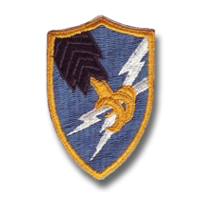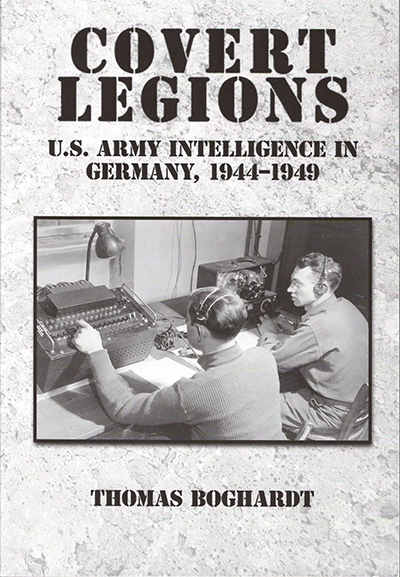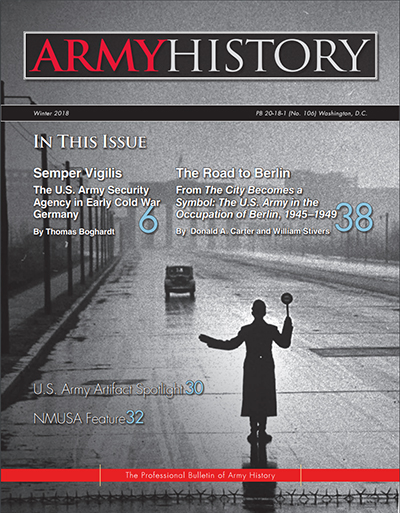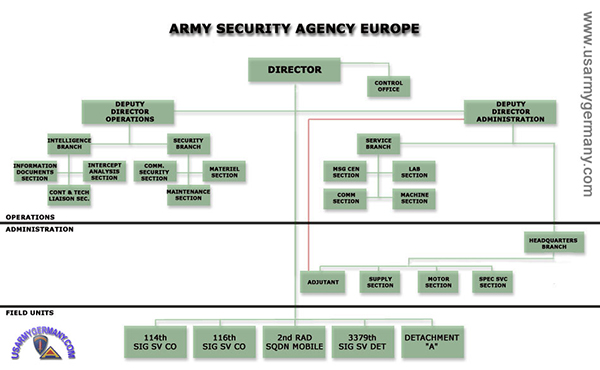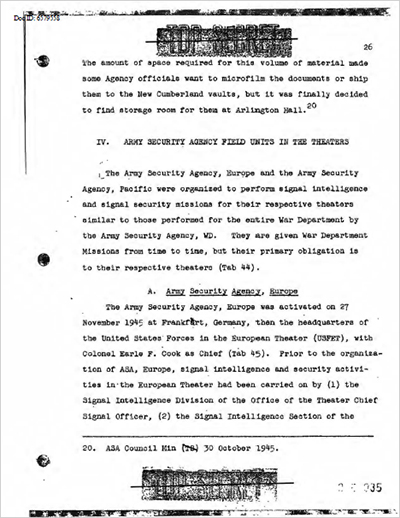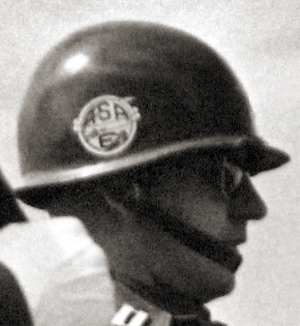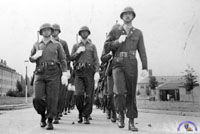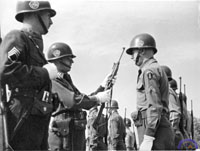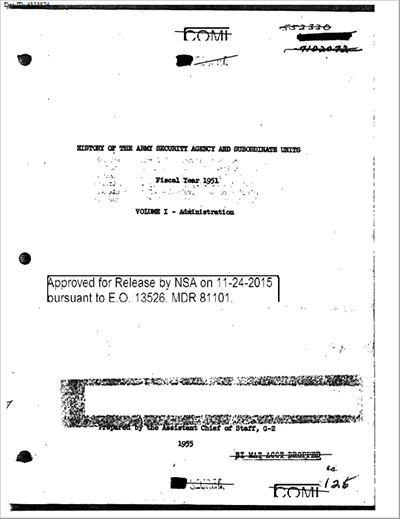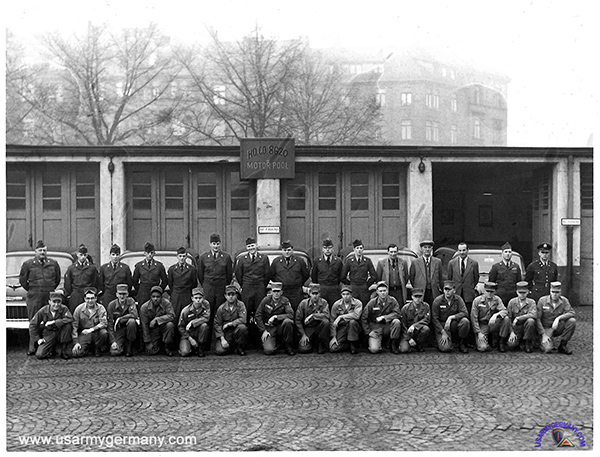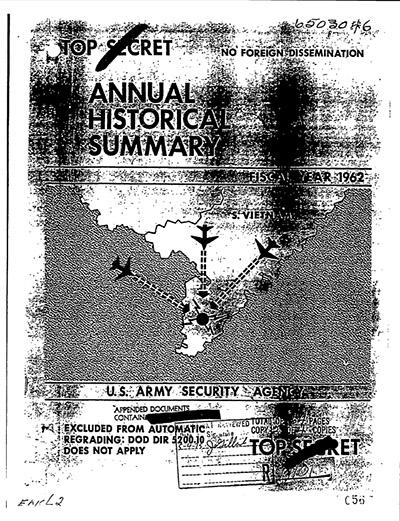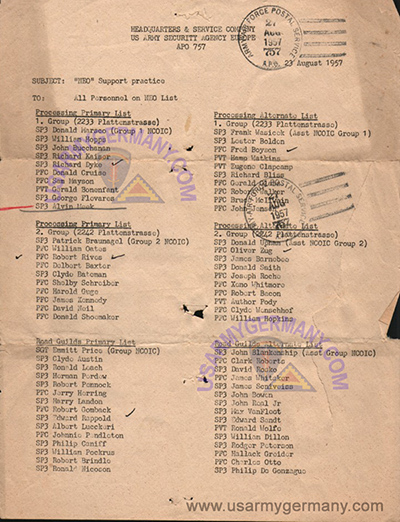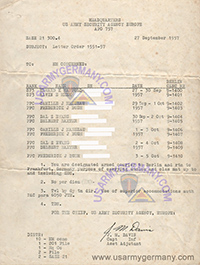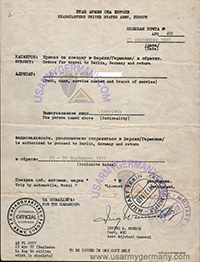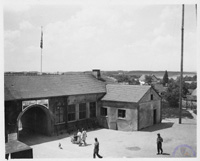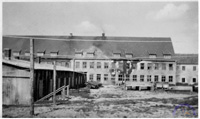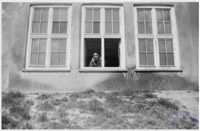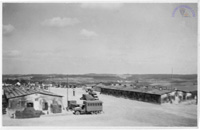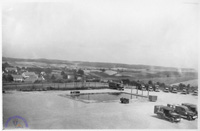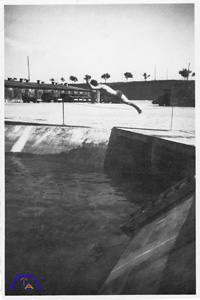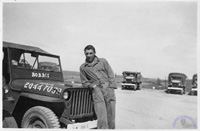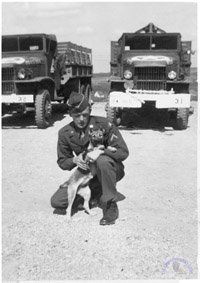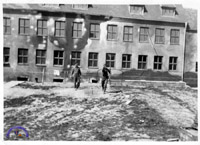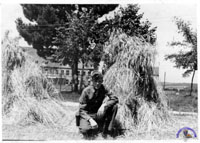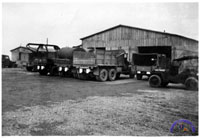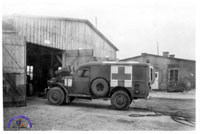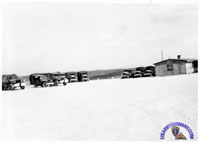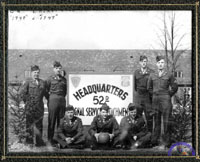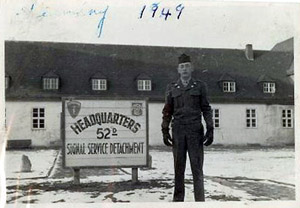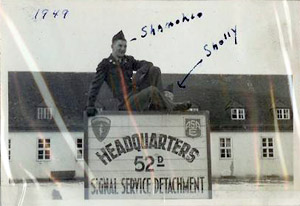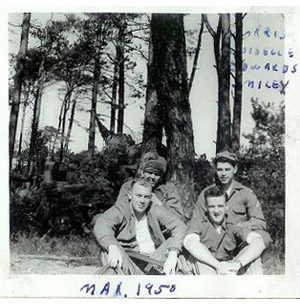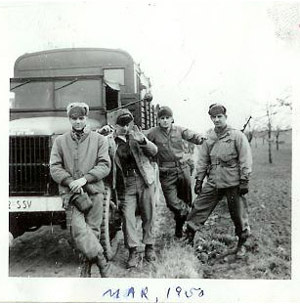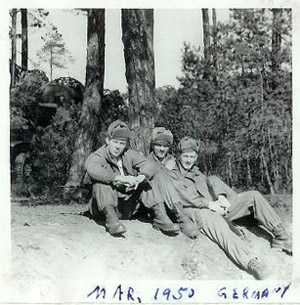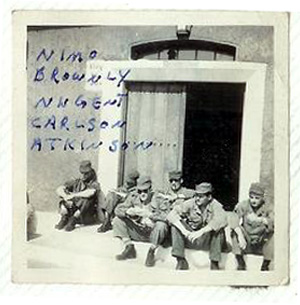| If you do NOT see the Table of Contents frame to the left of this page, then Click here to open 'USArmyGermany' frameset |
||||||||||||||||||||||||||||||||||||||||||||||||||||||||
|
Army Security Agency, Europe |
||||||||||||||||||||||||||||||||||||||||||||||||||||||||
|
|
||||||||||||||||||||||||||||||||||||||||||||||||||||||||
|
||||||||||||||||||||||||||||||||||||||||||||||||||||||||
|
|
||||||||||||||||||||||||||||||||||||||||||||||||||||||||
| Related Military History Publications | ||||||||||||||||||||||||||||||||||||||||||||||||||||||||
|
||||||||||||||||||||||||||||||||||||||||||||||||||||||||
| Both publications are available through the US Army Center of Military History website at https://history.army.mil/ | ||||||||||||||||||||||||||||||||||||||||||||||||||||||||
| Headquarters, ASA-Europe (8620) | ||||||||||||||||||||||||||||||||||||||||||||||||||||||||
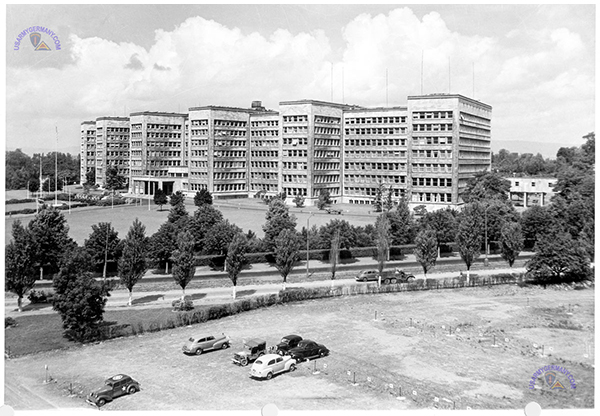 The IG Farben Building, Frankfurt, home of HQ ASA-Europe |
||||||||||||||||||||||||||||||||||||||||||||||||||||||||
| 1945 | ||||||||||||||||||||||||||||||||||||||||||||||||||||||||
| (Source: various sources, Walter Elkins) | ||||||||||||||||||||||||||||||||||||||||||||||||||||||||
|
Signal
Security Detachment D,
Signal Intelligence Div, HQ ETOUSA was attached to the 12th Army
Group and operated under the control of G-2 Division, 12th AG. The
unit furnished signal intelligence support at the army group level.
Immediately after the war, the Detachment was located in Rüsselsheim and became a major unit of USFET (and probably under direct control of that HQ) in mid Sept 1945. The Det has its own teletype circuit (DANA) to HQ USFET (DAAA). The Army Security Agency, Europe (ASAE) was established in Rüsselsheim, Germany, on November 27, 1945 as the European theater headquarters for the Army Security Agency. Its mission was to provide signal intelligence and communications security support to U.S. Forces, Europe and its subordinate commands. (I am assuming that ASAE took over the mission and resources of Sig Scty Det D.) Upon activation, ASAE assumed command of all signal intelligence units in Europe. This included any signal intelligence assets (probably "Detachment 6" or a predecessor) belonging to the former Signal Security Agency and its collection arm, the 2nd Signal Service Battalion, as well as all signal intelligence units previously subordinated to theater and Army commanders (mobile signal service units). ASAE thus exercised control over air and ground SIGINT and COMSEC units such as (field stations), signal service (radio intelligence) companies, signal service (security) detachments, and AAF mobile radio squadrons. In late 1946, the following units were attached to ASAE: |
||||||||||||||||||||||||||||||||||||||||||||||||||||||||
|
||||||||||||||||||||||||||||||||||||||||||||||||||||||||
| 1946 | ||||||||||||||||||||||||||||||||||||||||||||||||||||||||
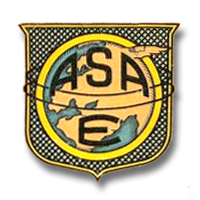 ASA Europe insignia (decal) - need confirmation that this is accurate ASA Europe insignia (decal) - need confirmation that this is accurate |
||||||||||||||||||||||||||||||||||||||||||||||||||||||||
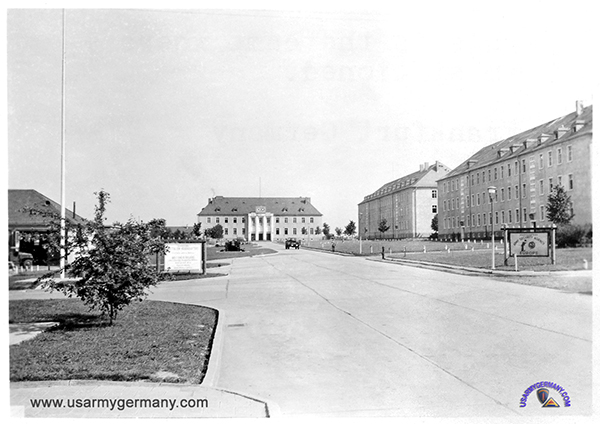 Gibbs Kaserne, Frankfurt, 1948 (Webmaster's collection) (Unit sign on right reads: "Headquarters Army Securty Agency Europe") |
||||||||||||||||||||||||||||||||||||||||||||||||||||||||
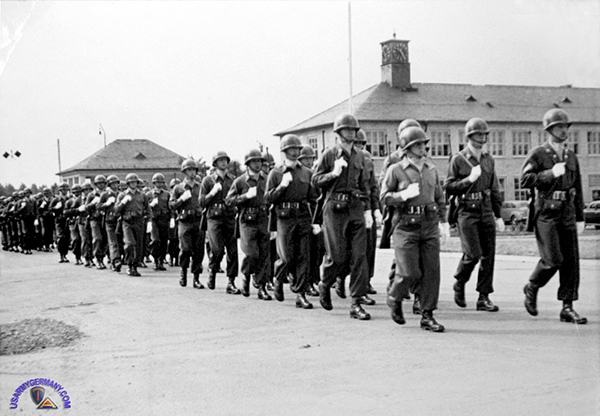 ASA-Europe parade at Gibbs Barracks, late 1940s |
||||||||||||||||||||||||||||||||||||||||||||||||||||||||
In
March 1946, HQ ASAE was moved to Gutleut Kaserne in Frankfurt for
billeting purposes. Operations were conducted in the IG Farben Hochhaus
in Frankfurt. At some point, probably early 1950, HQ ASAE was redesignated as the ASA Europe, Hq Co, 8620th DU. Sometime before 1970, ASAE left Gutleut Kaserne and moved into Kennedy Kaserne, which was closer to the IG Farben Building. HQ USASAE moved to Flak Kaserne, Augsburg in June 1971. This move was a preamble to the consolidation of assets required for establishing Field Station, Augsburg. By June 1972, FSA was in full swing; the three supplanted stations, one large border site, three smaller sites, and HQ USASA Europe had been closed. |
||||||||||||||||||||||||||||||||||||||||||||||||||||||||
| On 1 July 1945 there were, subordinate to the Signal Intelligence Division, Hq, USFET: In August and September 1945 all Signal all Service Service companies were deactivated; and by the time of the reorganization only three Radio Intelligence companies (114th, 116th and 118th) remained. On 2 January 1946 these were redesignated as Signal Service Companies. The 118th was assigned to the occupation forces in Austria, where it was disbanded on 15 March 1946 because of insufficient personnel. By the end of the fiscal year ASA, Europe, consisted of a headquarters at Frankfurt, Germany and five operating units: Detachment "A" was deactivated on 1 July 1946 and reorganized under operational control of the War Depertment, exercised through the Army Security Agency as M8-6. The mission of ASA, Europe had been expanded on 13 February 1946 to include United States Forces in Austrla the Mediterranlan Theater of Operations. The intelligence mission was performed by the Intelligence Branch of Headquarters, ASA, Europe and the field units. Intercept operations were carried out on an extremely limited scale, most field units producing little or no traffic. The 114th and 116th Signal Service Companies spent most of their time building facilities and training new personnel, but the intercept station at Gross Gerau did produce some intercepts during the fiscal year, an activity which tapered off after November 1945. Most European military circuits and suspected German clandestine circuits were monitored. There was very little cryptanalytic activity in the European Theater during 1946. Most traffic requiring cryptanalysis was sent back to the United States, although on 15 January 1946 the Chief of the Agency was authorized by the Assistant Chief of Staff, G-2 to assign the French military cryptanalytical problem to ASA, Europe. |
||||||||||||||||||||||||||||||||||||||||||||||||||||||||
CORRECTIONS & ADDITIONS
Source: Email from Bill Wagner, April 1949 to May 1952) Headquarters and Headquarters Company, ASAE, was billeted at Marbach Kaserne (Gibbs Barracks, Block#1 until August, 1951, when it moved to Block#3). In December, 1951, Hq and Hq Co, ASAE moved to the Gutleut Kaserne, West Block. The actual Headquarters of ASAE was on the 7th floor, West Block, of the I.G. Farben Building. HQ ASAE was redesignated as the Headquarters, Army Security Agency Europe, 8620th Administrative Area Unit (AAU) sometime before 31 August, 1950. |
||||||||||||||||||||||||||||||||||||||||||||||||||||||||
| 1950 | ||||||||||||||||||||||||||||||||||||||||||||||||||||||||
| (Source: Email from Dwayne Barber, son of the late Herschel C. Barber, Hqs ASA-Europe) | ||||||||||||||||||||||||||||||||||||||||||||||||||||||||
|
||||||||||||||||||||||||||||||||||||||||||||||||||||||||
|
||||||||||||||||||||||||||||||||||||||||||||||||||||||||
| 1951 | ||||||||||||||||||||||||||||||||||||||||||||||||||||||||
| 1952 | ||||||||||||||||||||||||||||||||||||||||||||||||||||||||
| (Source: Email from Brock Carr, HQ ASE-Europe, 1952-54) | ||||||||||||||||||||||||||||||||||||||||||||||||||||||||
| I was with ASA, first at Vint Hill Farms, then Arlington Hall and ultimately in Gutleut Kaserne (behind the Frankfurt Hauptbahnhof (train station). I spent 28 months in Frankfurt and returned to the US in September 1954. Naturally I have a few memories that I could share. It would be remarkable if some of my old chums from ASA were still around. I haven't had a chance to read all of the material on the net, yet. I was telling my wife about the story about the pilot that was supposedly court martialed because of the I.G. Farben Building. As the story went, the pilots were told to level Frankfurt, except for this particular building, because it was planned to be the new European Command Headquarters (EUCOM). They were told that it would be a Court Martial Offense if they damaged it. Sure enough, one poor pilot's bombs "SKIP BOMBED" and took out a small corner of the building -- and he was Court Martialled, or so the story goes.
When I arrived there in early 1952, the Germans were working 7 days a week to rebuild Frankfurt, and it was almost complete. The exception was the "OPERA HOUSE" -- I believe all of the exterior walls were still standing, but it was only a shell, with nothing left standing inside. I believe you could see it, looking up the main street (strasse) from the Bahnhof. I spent a fair amount of my leisure time in a Bavarian Gasthaus at the Bahnhof, called Maiergustls'. It was quite popular for all GI's. As I recall there were four divisions located in and around Frankfurt, they were the 2d Armored (Hell on Wheels) Division, the 43rd Infantry, and two other's - maybe the 28th and 1st Infantry (but I am not certain). Some of the nicer post war activities ASAE performed: In my off duty time I was responsible for the company dark room (I was an amateur photographer (Oh yes, I have some nice shots inside the compound of Gutleut Kaserne, showing the deuce and a halfs in the motor pool all lined up, and some with the troops in formation) and I used to spend time in a small town that (understandably so) didn't like or accept American GI's.) but having a camera, rather than weapon, was accepted. To make a long story short (which I very rarely do), after all the bombings during WWII, there were about 100 or more orphans left in the area to be cared for. There was no orphange in the area to house and care for them, so the townspeople took the children into their homes. When I learned of this, and I saw how beautiful these young children were, I thought it would be nice if the town had a picnic for all of them and I acted as the official town photographer, taking a 8x10 photo of each child, taking it back to our company darkroom, developing and enlarging all pictures, and then going back to this (anti-GI town) and delivering each portrait to each home (I had two buddies, one was an ASA German linguist) , who helped me with the darkroom work and especially with the delivery to each home -- my knowledge of German was lacking, to say the least). The town had a beautiful young girl (named Hanalorre Schwanke) who also acted as my interpreter. The Company Comander (Captain Dugen) approved the use of materials expended (Photo Enlarging Paper and chemicals). We did all of this on our off duty time. The children loved the portraits, and their adoptive families really warmed up to the three of us. They still didn't want Soldiers visiting or dating their young daughters, but we were the privledged few that were invited to their weekly town dance at the townhall.
About ASAE: I was assigned to the Chief of ASAE for my 28 month tour. My memory is a little spotty, we're talking about 52-54 years ago. I never thought I would see info about ASA open for all to see. I remember signing that document swearing not to tell anyone about my service for 10 years. It appears from what I see on the net, that every so many years, they change their name. We were told to wear any patch and brass that we wanted. "Tell people that you are in the infantry, signal corps, etc. " Then, when we arrived in Frankfurt, we were shown a wall with about 500 passport sized photos, and told, "these are all the Soviet agents and sub-agents in the Frankfurt area. Before you got off the ship in Bremerhaven, their people were showing these agents a wall, just like this, and your picture is on it!. They are looking for you! Bartenders, Prostitutes, straight people, all types. When our people have accidents, like falling off trains, or are killed in a so-called drunken brawl in a gasthaus (bar), don't you believe that it was an accident. If you talk in your sleep, don't go with a prostitute, she may be an agent, or working for one. Then we walked out of the meeting, walked out into the motor pool area (middle of Gutleut Kaserne) and saw beautiful ASAE decals on all of our vehicles, telling the whole world that that 'TOP SECRET" ASA was stationed in Frankfurt. Wow!. We couldn't believe it. They even had small decals that you could put on your wallet, how about that. In any case, about 6 months later, all the decals were removed, and we just showed the 8606 AAU signs. We even caught one of our own Com Center officers selling our code rotors to the Russians. When we joined ASA, you wouldn't be accepted if you had a relative or connections with Russia or any countries behind the "Iron Curtain". The Captain who was caught had relatives in a communist country, but he got into ASA before they had that ruling about relatives. Oh well, that's how the cookie crumbles. Oh, info re ASAE: The Chief was Lt. Col. Richard C. Gales, he also had a WAC Major Martha Schuhart assigned to him. There was also a Major Fisher (he was a really nice, down to earth guy-and a good officer). All of us (the Secuity Division and the Operations Division) spent most of our time in the I.G. Farben Building. The company commander, was Captain Dugan, and the First Sgt was Willams (lovingly referred to as "Willie) by those who loved him. I am sorry to see that ASA has evolved to being assigned to different regular Infantry (and other groups). I would have to believe that a lot of secuity could be lost because ASA not being an independent intellegence group, reporting only to Washington. I'll tell you why. A team made up of several of us from HQ went out to see how good the secuity was -- One of our infantry divisions was going on maneuvers in the middle of the winter, with the French Army. Just as the enemy would do, we wore the patches and insignia of that division, went down to France, found the division's main signal battalion, cut into their wire and recorded everything that went through the heart of the division. Not only did we learn the grid coordinates of every outfit in the Division, we even recorded one Battalion Commander talking to another Battalion Commander, reviewing the location (grids) of their outfits. At one point, one officer said to the other, "Hey Joe, we really shouldn't be discussing the locations of our outfits over the wire, security regs and all that." To which the other officer responded, "what are you worried about, those Security people don't know what the hell they are doing." We didn't realize what we had on tape until we got back to Frankfurt. I forget how many days we listened to the tapes, had them all typed up and sent off to Washingtion. Some time later, 1-3 months, the General in charge of the Infantry Division came to see the Chief, and reamed his ass. He screamed "The next time you send your people out against my outfit, you give me advance notice." (As if the enemy would warn him that they were coming!). In any case, as the story goes, this incident was reported back to the Pentagon and a higher ranking General came down on the Infantry Division Gerneral and made it clear that in the future, he would not be warned, and that if he and his people did not comply with security requlations in the future, he may want to kiss his Army career good bye. You see my point. ASA needs to maintain its independance. Another nice story comes to mind. On one of our "The Russians are coming" trips into the hinterlands, we were all set for the night in our pup tents, when we were rousted out, and told that it was discovered that we had been hammering our tent pegs into what once was a WWII mine field that had not completely been cleared of the mines. You can immagine how fast we got out of that area. Let the good times roll. Ho, Ho.
One other fact about ASAE has been bothering me. During my 28 months -- I know Lt. Col. Richard C. Gales was the Chief, ASAE - but my memory is foggy. I'm not sure if there had been Two (2) Chiefs, one when I first was assigned and perhaps he shippen out several months later and was replaced by a new Chief? I don't recall exactly, I"ll have to look at some of the old papers (Orders and that kind of stuff) and in my photo album. In any case, yes, be my guest about any facts I give you. the more I think about it, I believe the first Chief ASAE either retired or rotated back to the United States, several months before I did. |
||||||||||||||||||||||||||||||||||||||||||||||||||||||||
| ADDITIONAL INFORMATION I just went through some old promotion orders and a reference letter given to me by the Chief, and I can now say for sure, that the new Chief, Lt. Col. Richard C. Gales arrived in Frankfurt in 1954, before I left in September. I remember that he wanted me sign up (re-enlist) for another three years and offered me an immediate promotion to Sgt. First Class (I was an E-5 Sgt) (and quaranteed me Master Sgt Stripes before the end of my second enlistment. He knew I had been thinking of staying in the Army, but I was so homesick (not being allowed to go home for 28 months, I refused. We (he and I) got along well and he just didn't want to break in a stranger in my place. So I went home, thinking that I still could re-enlist, if I wanted to, after going home. More ASAE facts: I have some names from my old documents. The Adjutant in January of 1953 was Captain Ralph G. Irish. Some of my buddies that I would love to hear from (if they are still kicking): Dale E. McGuire (Sgt) -- came from the mid-west. I remember that he was allowed to rotate back to the US before his scheduled date in order to "bring the crop in" -- obviously, he was a farmer. One of my favorite buddies and mentor was Roger Schleuter. I believe he had been a teacher of English (& perhaps, German?) He was constantly on my back about my NEW YAWK accent! He would constantly correct me, saying IT HAS AN "R" IN YORK, and po-ta-toes are not pronounced pitatis, etc. etc. etc. His constant harping and correcting were largely responsible for my decision to attend college when I returned to the US. I owe him a lot. And to top it off, not only was he a good teacher, he was a good friend and had a good sense of humor. Then there was Jesse L. Inman Jr. from Georgia (Atlanta or Savanah? We were going to buy a shrimp boat when we got out (and have it paid for within 2 years!) Jesse played football for Georgia Tech and was rather large and quite strong. Before leaving the states, he, I and Les Holmes (Maryland) spent some time at Fort Knox. Jesse was so strong, that one time we were kiddingly playing Judo in the barracks, he picked me up over his head, threw me at a wall (sheetrock) and I went right threw it, into the hallway. There I was, stunned, laying against the far wall in the hallway, and big Jesse stuck his head through the hole in the wall that I maded (or he made, depending on how your look at it) saying with his Southern accent, "Brock, Are you all right?" We had some great times. Les Holmes had just married, weeks before we shipped overseas. He was assigned to one of the outstations in Germany for his 28 months. He said the weather was so bad most of the year (lots of mud and rain) that they virtually never wore their Class A uniforms -- just fatigues, all year round. |
||||||||||||||||||||||||||||||||||||||||||||||||||||||||
| (Source: Email from Ray Grafflin, 534th AFA Bn and 7734th Sig Svc Pltn) | ||||||||||||||||||||||||||||||||||||||||||||||||||||||||
| I browsed the site and noticed that under Signal, another unit I was assigned to isn't listed - the 7734th Signal Service Platoon. This unit was tasked with monitoring Red Army electonic emissions over the Czech border. Base unit was located at various places in Frankfurt - Gutleut Kaserne, next to the Hauptbahnhof, Heddernheim in what normally would have been Dependent Quarters, and at Gibbs Barracks. The forward unit was located up on Mount Meissner with a whole lot of expensive electronics equiptment. We were 32 EM and 3 Officers. No one ever said so, but I suspect we were "owned" by one of the spook agencies. I do know that if we wanted anything for the operational side, a phone call to Washington triggered a next day delivery via air from the States. We had a high proportion of degree level troops, who had a neat lab and really odd senses of humor |
||||||||||||||||||||||||||||||||||||||||||||||||||||||||
| 1955 | ||||||||||||||||||||||||||||||||||||||||||||||||||||||||
| (Source: Email from Myron Goff) | ||||||||||||||||||||||||||||||||||||||||||||||||||||||||
| I was with HQ 8620 DU from February 1955 to April 1956, and worked at the I.G.Farben Building and was billeted at the Gutleut Kaserne. I worked the dark room in the photo lab. I remember seeing bullet holes in the building from the pilot who straffed it. The paternosters were a real trip, having to jump on and off at your floor. Our floor was always gated with two MP's on guard at all times. If you have any info on this period, I would appreciate hearing from you. We had badges we wore on our shoulders which were of a dragon, in green and gold. We also wore the flaming sword patch. I have a large aerial blow-up of the I.G. Farben building and a couple of smaller ones. I remember riding in duece & 1/2's to get to work. I also have some pics of Gutleut Kaserne, with big black letters painted on the motor pool wall, "IHTFA". |
||||||||||||||||||||||||||||||||||||||||||||||||||||||||
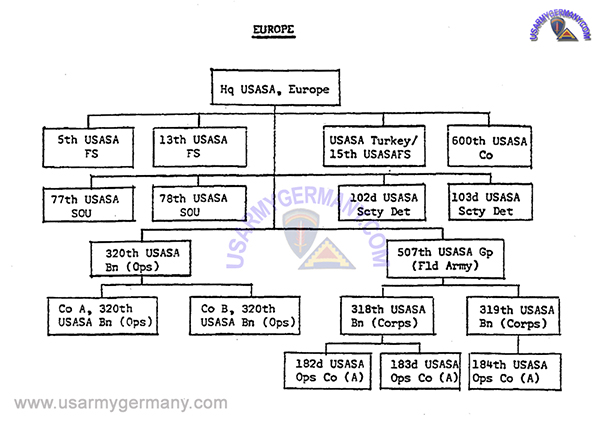 Organization of USASA, Europe in June 1962 |
||||||||||||||||||||||||||||||||||||||||||||||||||||||||
| 1956 | ||||||||||||||||||||||||||||||||||||||||||||||||||||||||
| (Source: ASA Annual ) | ||||||||||||||||||||||||||||||||||||||||||||||||||||||||
| The organizational structure of ASA-Europe was changed during FY 1956 by the relocation or redesignation of a number of units. ln August 1955, for example, Hq & Hq Co and Company B, 307th Battalion relocated from Giessen, Germany to Rothwesten. In November, the 332d Company relocated from Bamberg to Bad Aibling, and the 853d Comm Recon Detachment was inactivated and replaced by the 17th ASA Detachment. Undoubtedly, the most significant change was brought about by AR 10-122 which relieved the Agency of certain cryptologistic functiona, but added ELINT and communications countermeasures. This alone brought about. the transfer of several detachments from the Signal Corps, the majority of which were strategic ELI.NT collection units. Following their transfer, a provisional ELINT organization was developed by the command establishing the 20th ASA Detachment as a supervisory EIINT function. The s i x subordinate detachments were attached to the 20th for administration, operational control, or logistic support. A listing of these units follows. By the end of FY 1956 (June 30, 1956), 24 ASA units were deployed throughout Europe as opposed to 18 at the end of FY 1955. Included were the following: |
||||||||||||||||||||||||||||||||||||||||||||||||||||||||
|
||||||||||||||||||||||||||||||||||||||||||||||||||||||||
| (Source: Email from Alvin E. Meek) | ||||||||||||||||||||||||||||||||||||||||||||||||||||||||
| I served with 8620 ASA Bn from Oct 1956 to Feb 1958 in Frankfurt as a clerk in the Personnel Office. I also was trained as a truck driver for NEO (Non-combatant Evacuation Orders) and made armed courier runs to Berlin with classified material. 8620 ASA BN Frankfurt was Hq ASA Europe. NEO was the plan to evacuate civilian dependents to the coast of France (destination unknown) in a convoy with a deuce and a half truck between every six dependent vehicles. No maids and no pets allowed. |
||||||||||||||||||||||||||||||||||||||||||||||||||||||||
|
||||||||||||||||||||||||||||||||||||||||||||||||||||||||
| 1962 | ||||||||||||||||||||||||||||||||||||||||||||||||||||||||
| (Source: USASA Annual Historical Summary, Fiscal Year 1962 - reporting period 1 July 1961 - 30 June 1962) | ||||||||||||||||||||||||||||||||||||||||||||||||||||||||
| Colonel Robert E. Schukraft, SigC, 018744, was Chief, USASA, Europe from 1 July 61 to 30 Nov 61. Colonel James H. Keller, Inf, 021871, assumed command, 1 Dec 61, and remained as Chief, USASA, Eruope through the end of the fiscal year. | ||||||||||||||||||||||||||||||||||||||||||||||||||||||||
| 1964 | ||||||||||||||||||||||||||||||||||||||||||||||||||||||||
| (Source: Email from Sid Metcalf, July 1964 - December 1965) | ||||||||||||||||||||||||||||||||||||||||||||||||||||||||
| I was stationed at HQ USASAE in Frankfort from July 1964 until December 1965. When I first arrived we were housed at a place across the street from the I G Farben building called The White House. It had been an office building or school before the Army got it. My first job was duty or dispatch driver which I worked at for 2 or 3 months. Then the deputy chief needed a driver so I moved up. He was a bird Col. Lamee. Nice man. Soon the chief's driver had his third accident so I moved up again. At that time the chief was Col. Price. Also a very nice man. About 2 months later Col Price became Gen. Price and I stayed with him the rest of my time. We only lived at the White House for a short time, and they moved us to Gutleut Kaserne. Wasn't as nice but nobody bothered us. I wasn't due to rotate until Jan. but they let a few of us go mome before Christmas 1965. Since then I have lived and farmed in NW Kansas. |
||||||||||||||||||||||||||||||||||||||||||||||||||||||||
| (Source: Email from Jim Bair, Hq & Svc Co, 1964-68) | ||||||||||||||||||||||||||||||||||||||||||||||||||||||||
|
I served in the Personnel and Finance Office from Sept 1964 – sometime in 1966 when I was sent TDY to the 18th F&AO in Frankfurt to help set up a new computerized payroll system that the Army was instituting. |
||||||||||||||||||||||||||||||||||||||||||||||||||||||||
| 1968 | ||||||||||||||||||||||||||||||||||||||||||||||||||||||||
| (Source: Email from Francis Hamit) | ||||||||||||||||||||||||||||||||||||||||||||||||||||||||
| A couple of things about HQ USASA Europe. HQ was located on the 4th, 5th, 6th and 7th floors of that end of the building. Travel between floors was a unique elevator system called "paternosters." These were wood cabinets that moved continuously. The building is now the Humanities Building for the University of Frankfurt and these relics have been preserved. HQ for V Corps was on the bottom floors of the building. Kennedy Kaserne was home to HQ & Service Co and Com Unit before 1968, when I arrived there. It was a former girls' school and had an authorized EM club in the basement that served alcoholic beverages. It was called "The Spookeasy". There was also an Arms Room. Armed drills were held about once every three months. The HQ had an award winning unit newspaper, "The Frankfurter Forum," which won both Best in ASA and Best in Army for the multilith category. Copies of this newspaper are now in the Army Intelligence Museum at Fort Huachuca. You'll have to look at a map for exact directions, but my memory is that Kennedy Kaserne was across the street and to the left of the front of the Farben Bldg. It occupied most of the block at the corner of that street and Eschersheimer Landstrasse. The Officer's Club was directly behind the Farben Bldg. You could, if so inclined, walk down the street in front of the Farben Bldg all the way the Hauptbahnhof (main train station). That took you through the Kaiserstrasse area, where all the strip clubs and like amusements were located. Walking the other way took you to the Hauptwache, which was this great shopping area that had movie theaters that showed films in English and German on alternative showing. Took one of my German girlfriends to see "Easy Rider" there. She was shocked at the violence. The quickest way there was the U-Bahn (subway). Also there was our favorite bar, the Mausefalle (Mouse Trap), which had beautiful Chichi bar maids and one of our CI guys always lurking around. Walking the other way (North?) on Eschersheimer Landstrasse took you to the PX and the Topper Club, which was for E-5's and above and where you could buy a Heineken for 20 cents and a shot of Jack Daniels for two bits. The street between that corner that ran parallel led to the mess hall and the medical dispensary. There was a married housing and an American dependents school beyond the PX. Below the Hauptwache was the Staatsbühne (State Theatre) and the Opera. Next to the train station is the Messe Halle where they have the International Book Fair every October and where touring rock group would also perform. |
||||||||||||||||||||||||||||||||||||||||||||||||||||||||
|
|
||||||||||||||||||||||||||||||||||||||||||||||||||||||||
| 1945 - 1951 | ||||||||||||||||||||||||||||||||||||||||||||||||||||||||
| 114th Signal Service Company | ||||||||||||||||||||||||||||||||||||||||||||||||||||||||
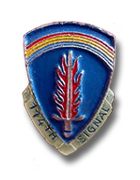 114th Signal
Company DUI
114th Signal
Company DUI |
||||||||||||||||||||||||||||||||||||||||||||||||||||||||
| During World
War II, the 114th Signal Radio Intercept Company was one of several
radio intelligence units allocated in support of 12th US Army Group.
SRICs were attached to the various US Armies, the 114th being in support
of First US Army. The primary mission of a Signal Radio Intelligence
unit was to intercept and record enemy radio transmissions and to
determine their locations by means of radio direction finders. The
SRI Co typically consisted of the following elements: In the immediate post-war period, the 114th was assigned to Signal Service Det D, Special Troops, 12th Army Group in Rüsselsheim, Germany. Det D served as the central command-and-control element for all signal intelligence operations conducted by the 12th Army Group and would eventually become ASA-Europe (Nov 1945). On Jan 10 1946, the 114th SRI Company was reorganized and redesignated as 114th Signal Service Company. The 114th Sig Svc Company was located in Sontra, Germany until May 1947. On 14 May 1947, the Sontra site was closed - the Company with its support personnel were sent to Herzo Base, the radio operators were reassigned to the 116th Sig. Svc. Co. which was located in Scheyern, Germany. In 1949, a detachment of the 114th (Det "A") was located at the old German Fliegerhorst in Rothwesten. With the growing fear of Soviet aggression in Europe after the war in Korea started in the summer of 1950, the 114th and its sister unit, the 116th, were ordered to remount (on 2½-ton trucks) their WWII-vintage intercept and communications equipment (TC-9's and SCR-399's?) and assume a tactical role as support units for 7th Army. (As the SRI's had settled in to occupational duty after the end of WWII, their truck-mounted equipment had been dismounted and operations were performed in a fixed-site mode.) In May 1951, the 114th Sig Svc Co was relocated to Kinglsey Barracks, Hof to be closer to the border. On 25 Oct 1951, the 114th Sig Svc Co was reorganized and re-designated as the 331st Communications Reconnaissance Company and allotted to Regular Army. |
||||||||||||||||||||||||||||||||||||||||||||||||||||||||
| Visit Dean Slagle's wonderful page dedicated to the 331st C.R. Co. in Germany. Includes great photos of the 114th's home stations at Herzo and Hof (331st Communication Reconnaissance Company). | ||||||||||||||||||||||||||||||||||||||||||||||||||||||||
|
|
||||||||||||||||||||||||||||||||||||||||||||||||||||||||
| Looking for 114th SRI members who stayed at Avon Tyrrell, England | ||||||||||||||||||||||||||||||||||||||||||||||||||||||||
| We're
looking for anyone who was in the US Army 114th Signal Radio Intelligence
unit around D-day and in Germany afterwards. The unit was based at
our house (Avon Tyrrell) in the New Forest,
England before D-day. A couple of vets have visited and have given
us some great memories and photos, and we'd like to see if we can
get more. Avon Tyrrell is now a listed historic building and used
as a childrens activity centre - the US Army being based here, and
massing before D-day, is an important part of its history - we'd like
to keep a record of this and put up some displays for the visitors
that come here. Richard Louis Bonney Centre Director Avon Tyrrell Activity and Residential Centre UK Youth, Bransgore, Hampshire BH23 8EE Email: director@avontyrrell.org.uk Web Site: www.avontyrrell.org.uk |
||||||||||||||||||||||||||||||||||||||||||||||||||||||||
|
|
||||||||||||||||||||||||||||||||||||||||||||||||||||||||
| 1945 - 1951 | ||||||||||||||||||||||||||||||||||||||||||||||||||||||||
| 116th Signal Service Company | ||||||||||||||||||||||||||||||||||||||||||||||||||||||||
| (Source: Various ASA related websites, including a unit history posted on the ASA Alpiners website) | ||||||||||||||||||||||||||||||||||||||||||||||||||||||||
| The 116th Signal
Radio Intelligence Company, activated on 18 May 1942 at Camp Crowder,
Missouri, participated in several campaigns in the ETO, in support
of the 12th Army Group. The company was one of two Army radio intelligence companies left in Germany after redeployment. Both were located in the First Military District (Land Bavaria) area. On May 17 1945, the 116th had established its command post at Scheyern, Germany, about 35 miles from Munich, and soon began performing its intercept mission from there. The site was located on a former German Luftwaffe air base with family housing in the town of Pfaffenhofen. The operations center was located in the attic of a large German barracks which also contained the enlisted quarters, orderly room, dayroom, mess hall and arms room on the lower floors. A new two-story barracks was completed in 1948 to house new personnel arriving in the unit. The antenna field was located on farmland across from the Kaserne and contained 80-120 foot towers fitted with long-wire and rhombic antennas. On June 30 1945, the 116th was assigned to Det D of Special Troops, 12th Army Group. On July 30 1945, the company was relieved from 12th Army Group and assigned to the Third US Army. On 15 January 1946, the 116th Signal Radio Intelligence Company was redesignated as the 116th Signal Service Company with an effective strength of nine officers and 248 enlisted men. Effective 1 February 1946, the company was relieved from assignment to Third US Army (which was being inactivated at the time) and assigned to Headquarters, ASA Europe. Prior to the outbreak of the Korean Conflict (June 1950), the ASA units in Germany had become largely incapable of mobile operations due to the shortages of personnel and equipment. With tension's rising, the unit's operational shelters were again truck mounted and the unit was prepared for tactical ops. On 10 March 1951, a large contingent of the troops departed Scheyern and moved to Herzogenaurach, Germany, and from there to Coburg (on 16 April 1951), where it assumed full mobile operation. The troops remaining at Scheyern were re-designated as Field Station 8608 and operated as a fixed station. The 116th moved from Coburg, Germany, on 9 July 1951 to Baumholder, Germany, and then to Heilbronn, Germany on 22 August 1951. The unit was reorganized and redesignated on 25 October 1951 as the 332d Communications Reconnaissance Company, and concurrently allotted to the Regular Army. |
||||||||||||||||||||||||||||||||||||||||||||||||||||||||
| Visit Wade Temple's wonderful page dedicated to the 332nd C.R. Co. in Germany. Includes great photos of the 116th's home station at Scheyern (332nd Communication Reconnaissance Company). | ||||||||||||||||||||||||||||||||||||||||||||||||||||||||
| (Source: Email from Patrick Garrison, grandson of Roy Garrison, of the 116th Sig Svc Co) | ||||||||||||||||||||||||||||||||||||||||||||||||||||||||
| Roy Garrison served with the 116th Sig Sv Co in Germany at the end of WWII and during the early occupation period. At least that is what Patrick has been able to gather. Roy did not talk much about his unit or specifics of his assignments, but often talked of the people he met and the beautiful German countryside. After Roy passed away recently, Patrick found a cigar box full of photos from Roy's time in Germany. The following photos are a small sampling of these memories. Patrick hopes that someone viewing these images might recognize details or persons and be able to help fill in some of the gaps in his knowledge of his grandfather's unit and activities in Germany in the early days of the Occupation. |
||||||||||||||||||||||||||||||||||||||||||||||||||||||||
| Related Links | ||||||||||||||||||||||||||||||||||||||||||||||||||||||||
|
||||||||||||||||||||||||||||||||||||||||||||||||||||||||
| 1945 - 1951 | ||||||||||||||||||||||||||||||||||||||||||||||||||||||||
| 52nd Signal Service Detachment | ||||||||||||||||||||||||||||||||||||||||||||||||||||||||
| (Source: Email from Ronald R. Rehrer, 52nd Sig Svc Det, 1947-50) | ||||||||||||||||||||||||||||||||||||||||||||||||||||||||
| I was suprised to find such a wonderful website with all the units of ASA Europe included. But I never found my unit which was from 1947 to 1950 at Herzo Base, two years of which I served with the 52nd Signal Service Detachment. Our mission at the time was monitering all United States Army field communications in Germany. Also on base at the time were the 114th and 116th Signal Service Companies who were billeted aside of us. We spent much time in the field monitering US Army communications for violations of procedures. Our MOS at the time was 799 for high speed radio ops. Am enclosing several pictures of our unit between 1947 and 1950 at Herzo Base. Thanks for the visit to your great web site. |
||||||||||||||||||||||||||||||||||||||||||||||||||||||||
|
||||||||||||||||||||||||||||||||||||||||||||||||||||||||
|
||||||||||||||||||||||||||||||||||||||||||||||||||||||||
| Related
Links Field Station Berlin - FSB veterans Reunion Group with lots of information and photos. (Broken LINK) |
||||||||||||||||||||||||||||||||||||||||||||||||||||||||
|
||||||||||||||||||||||||||||||||||||||||||||||||||||||||
| Wurmberg - nice page on the ASA site at Wurmberg. Page is hosted on the German website - LostPlaces.de Gatow and Wobeck - nice page on the ASA sites at Gatow and Wobeck. Great photos of the Torii Towers!! Page is hosted on the German website - LostPlaces.de Nottau - Image Page by Joseph P. Strock bennettpics Online Photos - several photo albums with pictures of Badenerhof Kaserne and the 507th (502nd) ASA Group - if anyone has a current email address for Preston Bennett, the owner of the albums, please contact me ASA Veterans Reunions |
||||||||||||||||||||||||||||||||||||||||||||||||||||||||

